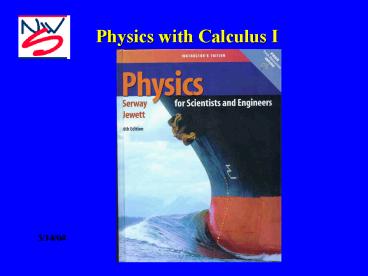Physics with Calculus I - PowerPoint PPT Presentation
1 / 19
Title:
Physics with Calculus I
Description:
... of the orbital period of any planet the cube of the semi major axis ... Escape Velocity: Minimum velocity a body must have to escape Earth's gravity field. ... – PowerPoint PPT presentation
Number of Views:36
Avg rating:3.0/5.0
Title: Physics with Calculus I
1
Physics with Calculus I
5/14/04
2
(No Transcript)
3
Where weve been
- Newtons Laws of Motion
- Work Power
- Conservation of energy
- Conservation of momentum
- Rotational Motion
- Angular Momentum (L)
- Static Equilibrium
4
Ch 13 Introduction
The Moon orbits about the Earth and hence,
according to Newtons laws of motion, deviates
from a straight path, and that must be due to a
force acting on it. Likewise, the Moon must
exert a reaction force on the Earth. Newton knew
that the Earths gravity causes objects to fall
towards the Earth and thus thinking about the
Moon also falling toward the Earth in its
orbit, he reasoned that it was the Earths
gravity that provided the centripetal force
needed to make the Moon orbit as it does. He was
well on his way to determining the law of
gravity.
5
Where were going
Ch 13 The Law Of Gravity (13.1) Newtons Law of
Universal Gravitation (13.2) Measuring G (not
to be confused with g) (13.3) g and force due
to gravity (13.4) Keplers Laws and the motion of
planets (13.5) The Gravitational Field (13.6)
Gravity and potential energy Escape velocity
6
(13.1) Newtons Law of Universal Gravitation
Inverse Square Law
Works ONLY for point masses
7
(13.1) Newtons Law of Universal Gravitation
Force felt by m2 due to presence of m1
Problem 13.5 From chapter 6 Weightless
Astronauts
8
(13.2) Measuring G, the universal gravitational
constant
Careful
You should read the story of how Mr. Cavendish
accomplished this
9
(13.3) g and Force Due to Gravity
Assume your mass, m you 100 kg m Earth 5.98
(10)24 kg r Earth 6.37 (10) 6 m Calculate the
acceleration you feel due to gravity
10
(13.4) Keplers Laws
- All planets move in elliptical orbits
- The radius vector drawn from sun to any planet
sweeps out equal areas in equal time intervals - The square of the orbital period of any planet ?
the cube of the semi major axis of the
elliptical orbit
11
(13.5) Gravity and the motion of planets
Where r ? semimajor axis
Now, determine period of Earth about Sun
12
(13.6) The Gravitational Field
The Gravitational Field ?
Work-out the units
13
(13.6) The Gravitational Field
So, Gravitational Field Strength does NOT involve
an objects mass. Every mass (at sea level)
experiences the same acceleration (due to
gravity)
14
(13.7) Gravity and Potential Energy
From Chapter 8
15
(13.7) Gravity and Potential Energy
From previous slide
Where r gt r Earth
16
(13.7) Gravity and potential energy
Now, if we take U o 0 _at_ r o ?, we have
Problem 13.29
17
(13.8) Escape velocity
- Escape Velocity Minimum velocity a body must
have to escape Earths gravity field. - That is, just reach r ? with velocity 0.
Solve for escape velocity (from Earth)
Note Velocity is INdependent of mass
18
Oh, what to do when mass in NOT a point mass?????
- Of course, add up the Force due to EACH little
bit of mass. - Or, use that upside-down math called calculus.
h
L
m1
Calculate the force felt by the small mass at the
origin due to the extended mass.
19
The End































